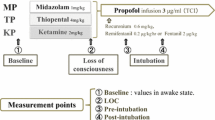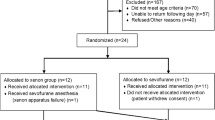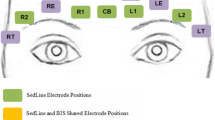Abstract
Bispectral index (BIS) and auditory evoked potential (AEP) monitoring require the attachment of forehead sensors, posing difficulties when the surgical field involves the forehead. This study analyzed the relationship between BIS values and AEP indices from different sites on the head to establish alternative sensor locations for AEP recording. Thirty patients scheduled for elective surgery under sevoflurane anesthesia were randomly assigned to the forehead, nose or mandible groups (n = 10 patients per group). AEP sensors were placed at the assigned position for each group and BIS sensors were placed on the forehead. BIS value and AEP index were simultaneously recorded from induction until emergence from general anesthesia. Relationships between BIS values and AEP indices were analyzed using a regression method and compared between groups using Pearson’s correlation coefficients. Square regression models better expressed the relationships than linear models in all groups. The z-transformed coefficient in the forehead group was the same as the nose group (p = 0.24) and significantly different in the mandible group (p = 0.0046). These findings suggest that AEPs can be accurately recorded from sensors placed on the nose. Nasal AEP might be useful for monitoring electrical activity in the brain during surgeries involving the forehead.


Similar content being viewed by others
References
Sigl JC, Chamoun NG. An introduction to bispectral analysis for the electroencephalogram. J Clin Monit. 1994;10:392–404.
Pollock JE, Neal JM, Liu SS, Burkhead D, Polissar N. Sedation during spinal anesthesia. Anesthesiology. 2000;93:728–34.
Drummond JC. Monitoring depth of anesthesia: with emphasis on the application of the bispectral index and the middle latency auditory evoked response to the prevention of recall. Anesthesiology. 2000;93:876–82.
Thornton C, Sharpe RM. Evoked responses in anaesthesia. Br J Anaesth. 1998;81:771–81.
Mantzaridis H, Kenny GN. Auditory evoked potential index: a quantitative measure of changes in auditory evoked potentials during general anaesthesia. Anaesthesia. 1997;52:1030–6.
Stoppe C, Peters D, Fahlenkamp AV, Cremer J, Rex S, Schälte G, Rossaint R, Coburn M. AepEX monitor for the measurement of hypnotic depth in patients undergoing balanced xenon anaesthesia. Br J Anaesth. 2012;108:80–8.
Bland JM, Altman DG. Measuring agreement in method comparison studies. Stat Methods Med Res. 1999;8:135–60.
Schwender D, Kaiser A, Klasing S, Peter K, Pöppel E. Midlatency auditory evoked potentials and explicit and implicit memory in patients undergoing cardiac surgery. Anesthesiology. 1994;80:493–501.
Lawley D. Tests of significance in canonical analysis. Biometrika. 1959;46:59–66.
Konishi S. Normalizing transformations of some statistics in multivariate analysis. Biometrika. 1981;68:647–51.
Konishi S, Gupta AK. Testing the equality of several intraclass correlation coefficients. J Stat Plan Inference. 1989;21:93–105.
Gajraj RJ, Doi M, Mantzaridis H, Kenny GN. Analysis of the EEG bispectrum, auditory evoked potentials and the EEG power spectrum during repeated transitions from consciousness to unconsciousness. Br J Anaesth. 1998;80:46–52.
Kurita T, Doi M, Katoh T, Sano H, Sato S, Mantzaridis H, Kenny GN. Auditory evoked potential index predicts the depth of sedation and movement in response to skin incision during sevoflurane anesthesia. Anesthesiology. 2001;95:364–70.
Newton DE, Thornton C, Konieczko KM, Jordan C, Webster NR, Luff NP, Frith CD, Doré CJ. Auditory evoked response and awareness: a study in volunteers at sub-MAC concentrations of isoflurane. Br J Anaesth. 1992;69:122–9.
Pandin P, Van Cutsem N, Tuna T, D’Hollander A. Bispectral index is a topographically dependent variable in patients receiving propofol anaesthesia. Br J Anaesth. 2006;97:676–80.
Walter DO, Etevenon P, Pidoux B, Tortrat D, Guillou S. Computerized topo-EEG spectral maps: difficulties and perspectives. Neuropsychobiology. 1984;11:264–72.
Hemmerling TM, Deschamps S, Michaud G, Trager G. An unusual site for bis monitoring. Anesth Analg. 2004;99:1264–5.
Shiraishi T, Uchino H, Sagara T, Ishii N. A comparison of frontal and occipital bispectral index values obtained during neurosurgical procedures. Anesth Analg. 2004;98:1773–5.
Nelson P, Nelson JA, Chen AJ, Kofke WA. An alternative position for the BIS-Vista montage in frontal approach neurosurgical cases. J Neurosurg Anesthesiol. 2013;25:135–42.
Wood CC, Wolpaw JR. Scalp distribution of human auditory evoked potentials. II. Evidence for overlapping sources and involvement of auditory cortex. Electroencephalogr Clin Neurophysiol. 1982;54:25–38.
Cacace AT, Satya-Murti S, Wolpaw JR. Human middle-latency auditory evoked potentials: vertex and temporal components. Electroencephalogr Clin Neurophysiol. 1990;77:6–18.
Liégeois-Chauvel C, Musolino A, Badier JM, Marquis P, Chauvel P. Evoked potentials recorded from the auditory cortex in man: evaluation and topography of the middle latency components. Electroencephalogr Clin Neurophysiol. 1994;92:204–14.
Heneghan CP, Thornton C, Navaratnarajah M, Jones JG. Effect of isoflurane on the auditory evoked response in man. Br J Anaesth. 1987;59:277–82.
Akay M, Daubenspeck JA. Respiratory related evoked responses to graduated pressure pulses using wavelet transform methods. Ann Biomed Eng. 2000;28:1126–35.
Tsai S-W, Tsai C-L, Wu P-T, Wu C-Y, Liu C-L, Jou I-M. Intraoperative use of somatosensory-evoked potential in monitoring nerve roots. J Clin Neurophysiol. 2012;29:110–7.
Avidan MS, Zhang L, Burnside BA, Finkel KJ, Searleman AC, Selvidge JA, Saager L, Turner MS, Rao S, Bottros M, Hantler C, Jacobsohn E, Evers AS. Anesthesia awareness and the bispectral index. N Engl J Med. 2008;358:1097–108.
Avidan MS, Jacobsohn E, Glick D, Burnside BA, Zhang L, Villafranca A, Karl L, Kamal S, Torres B, O’Connor M, Evers AS, Gradwohl S, Lin N, Palanca BJ, Mashour GA. Prevention of intraoperative awareness in a high-risk surgical population. N Engl J Med. 2011;365:591–600.
Tourtier JP, Le Moullec D, Auroy Y. Prevention of intraoperative awareness. New Engl J Med. 2011;365:2032–5.
Acknowledgments
The author (S.S.) thanks the staff of the Department of Anesthesiology, Sapporo Medical University School of Medicine, for their warm encouragement regarding the preparation of this manuscript.
Author contributions
Y.I., S.S. and T.H. contributed equally to this work. Y.I. collected, analyzed and reviewed the data, and wrote the first draft of the manuscript. S.S. and T.H. designed the experiments and conducted the study. They also analyzed the data and reviewed and revised the manuscript. P.K.J. helped prepare the manuscript and jointly developed the structure and arguments for the paper. All authors approved the final manuscript.
Funding
Departmental resources were used for preparing disposable sensors.
Author information
Authors and Affiliations
Corresponding author
Ethics declarations
Conflicts of interest
None.
Rights and permissions
About this article
Cite this article
Ishioka, Y., Sugino, S., Hayase, T. et al. Intraoperative auditory evoked potential recordings are more reliable at signal detection from different sensor sites on the forehead compared to bispectral index. J Clin Monit Comput 31, 117–122 (2017). https://doi.org/10.1007/s10877-015-9812-6
Received:
Accepted:
Published:
Issue Date:
DOI: https://doi.org/10.1007/s10877-015-9812-6




